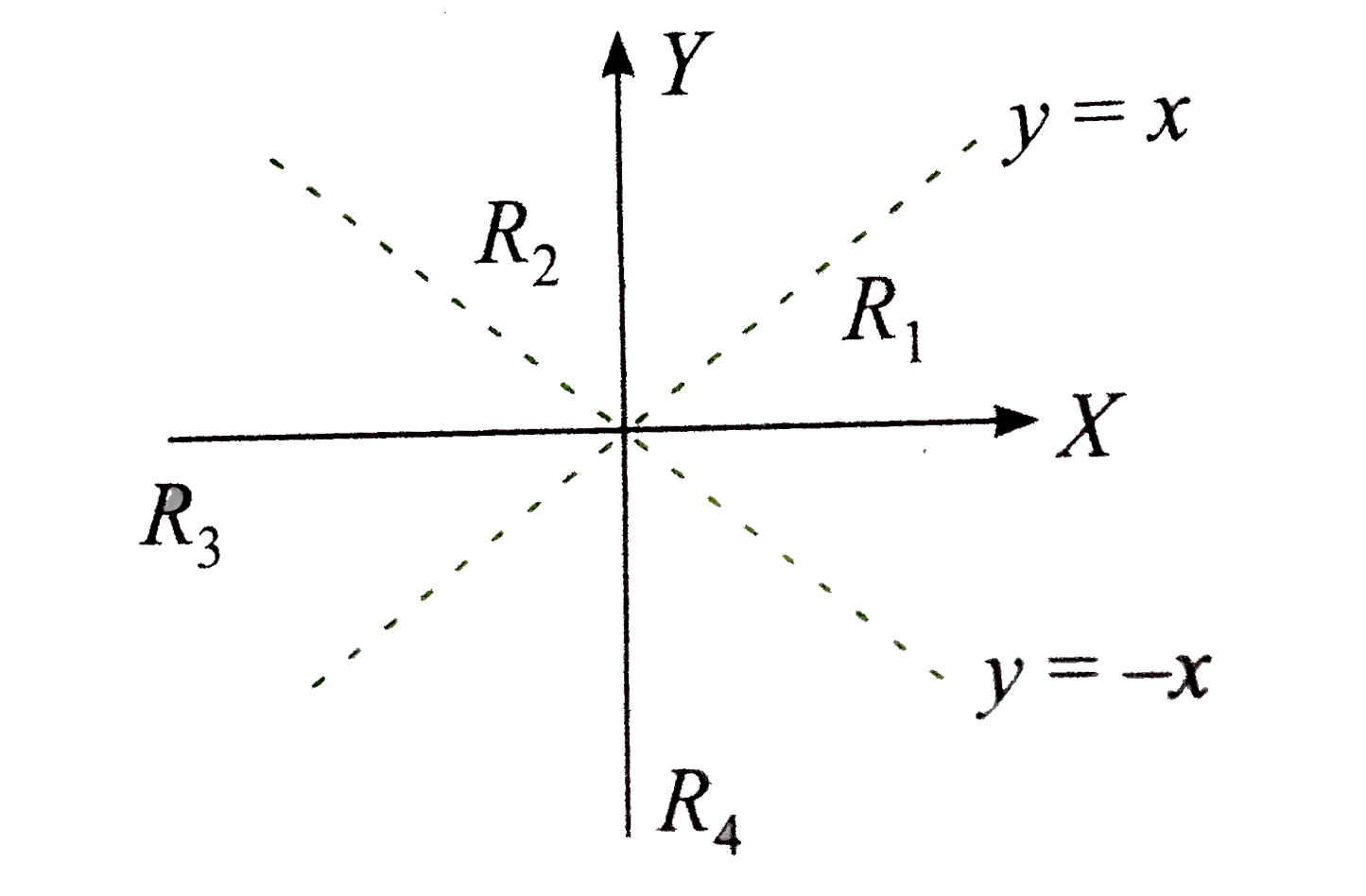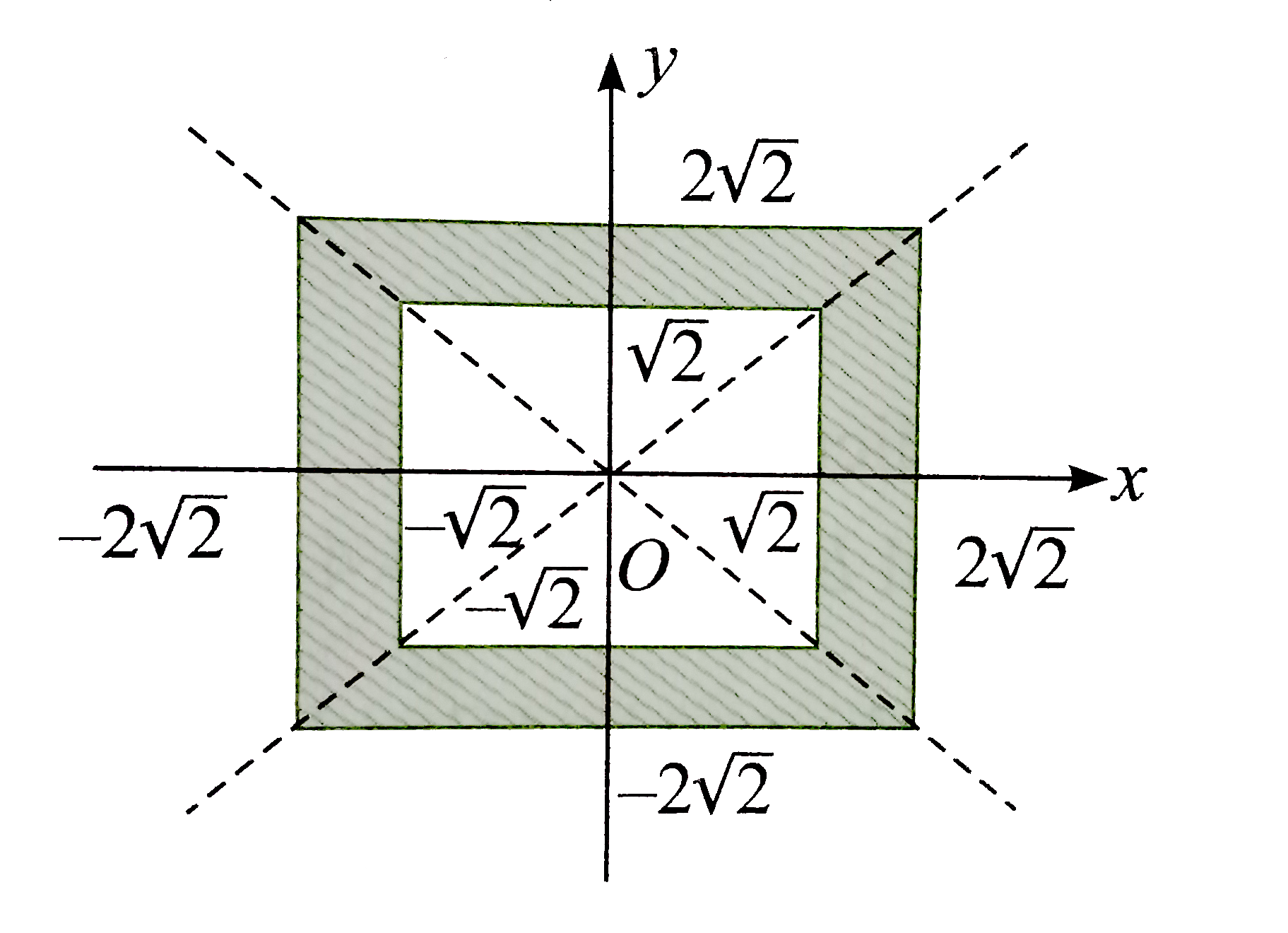Consider two lines L1andL2 given by x−y=0 and x+y=0 , respectively, and a moving point P(x,y). Let d(P,L1),i=1,2, represents the distance of point P from the line Lt If point P moves in a certain region R in such a way that 2≤d(P,P1)+d(P,L1)≤4 , find the area of region R.

d(P,L1)=|x−y|√2
and d(P,L2)=|x+y|√2
Now, we have
2≤d(P,L1)+d(P,L2)≤4
or 2√2≤|x−y|+|x+y|≤4√2 (1)
Now, let us consider the four regions, namely, R1,R2,R3 and R4, in the lines L1 and L2 dividing the coordinate plane.
InR1, we have y<x,y>−x.In R2, we have y>x,y>−x.Similarly,
InR3, we have y>x,y<−x.Finally, in R4, we have y<x,y<−x.
Thus , for R2, (1) becomes.
2√2≤x−y+x+y≤4√2 or√2≤x≤2√2
Similarly, for R2, (1) becomes
2√2≤y−x+x+y≤4√2 or√2≤y≤2√2
In R3 ,(1) will become
2√2≤y−x−x−y≤4√2 or−√2≤x≤−2√2
Finally, in R4, (1) will become
2√2≤x−y−x−y≤4√2
or −2√2≤y≤−2√2
Thus region R will be the region between concentric squares formed by the lines x=±√2,y=±√2 and x=±2√2,y=±2√2.
Thus the required are is (4√2)2−(2√2)2=24 units.

Topper's Solved these Questions
- BOOK - CENGAGECHAPTER - STRAIGHT LINESEXERCISE - Exercise 2.123videos
STRAIGHT LINES
- BOOK - CENGAGECHAPTER - STRAIGHT LINESEXERCISE - Exercise 2.24videos
STRAIGHT LINES
- BOOK - CENGAGECHAPTER - STRAIGHT LINEEXERCISE - Multiple Correct Answers Type8videos
STRAIGHT LINE
- BOOK - CENGAGECHAPTER - THEORY OF EQUATIONSEXERCISE - JEE Advanced Previous Year9videos
THEORY OF EQUATIONS
Similar Questions
Find the distance of the point P from the line l in that : l:12x−7=0≡(3,−1)
View SolutionFind the distance of the point P from the line l in that : l:xa−yb=1andP≡(b,a)
View SolutionFind the distance of the point P from the line l in that : l:12(x+6)=5(y−2)andP-=(-3, -4)
View SolutionFind the distance of the point P from the line l in that : l:12(x+6)=5(y−2)andP≡(−1,1)
View SolutionConsider two lines L1andL2 given by a1x+b1y+c1=0anda2x+b2y+c2=0respectivelywherec1andc2≠0, intersecting at point P.A line L3 is drawn through the origin meeting the lines L1andL2 at AandB, respectively, such that PA=PB . Similarly, one more line L4 is drawn through the origin meeting the lines L1andL2 at A1andB2, respectively, such that PA1=PB1. Obtain the combined equation of lines L3andL4.
View SolutionFor a point P in the plane let d1(P)andd2 be the distance of the point P from the lines x−y=0 R consisting of all points P lying in the first quadrant of the plane and satisfying 2≥d1(P)+d2(P)≥4, is
View SolutionConsider the lines L1andL2 defined by
L1:x√2+y−1=0andL2:x√2−y+1=0
For a fixed constant λ, let C be the locus of a point P such that the product of the distance of P from L1 and the distance of P from L2 is λ2. The line y=2x+1 meets C at two points R and S, where the distance between R and S is √270.
Let the perpendicular bisector of RS meet C at two distinct points R' and S' . Let D be the square of the distance between R' and S'.
The value of D isView SolutionConsider the lines L1andL2 defined by
L1:x√2+y−1=0andL2:x√2−y+1=0
For a fixed constant λ, let C be the locus of a point P such that the product of the distance of P from L1 and the distance of P from L2 is λ2. The line y=2x+1 meets C at two points R and S, where the distance between R and S is √270.
Let the perpendicular bisector of RS meet C at two distinct points R' and S' . Let D be the square of the distance between R' and S'.
The value of λ2 isView SolutionConsider the bisector (L=0) of the angle between the lines x+2y−11=0 and 3x–6y−5=0 (the region) which contains the point A(1,−3). Let P(a,1) and Q(b,2) be two points lying on this line (L=0). Then
View SolutionFind the image of the point p wrt the plane L where P≡(1,2,3)andL=2x+2y+4z=38
View Solution

